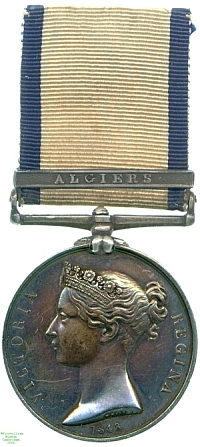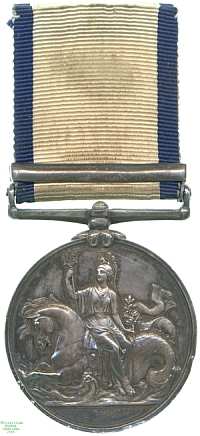
Obverse, a bust of Queen Victoria

Reverse, Britannia with a trident seated sideways on a seahorse

Obverse, a bust of Queen Victoria |

Reverse, Britannia with a trident seated sideways on a seahorse |
Just as in 1848 the extensive land campaigns of the Napoleonic Wars and the other conflicts of the pre-Victorian era were recognised by the issue of the Miltary General Service Medal, those serving in the Navy at the time were recognised with the Naval General Service Medal. As with the Army equivalent and the East India Company's related award, many of the battles for which the medal was awarded had been fought so long ago that few if any claimants survived.
In addition, bars were awarded for many actions whose significance and size were, despite the heroism displayed by those involved, relatively minor. The result was that many of the bars were issued in tiny numbers, with some combinations all but unique, and the medals command a very high price among collectors because of this rarity and individuality. This in turn, along with the manufacture in most cases of more bars than were eventually issued, has led to the `improvement' of many common awards where recipients' names are shared with those present at `rarer' battles. The medal also shares with the Military General Service and Army of India Medals the oddity that Queen Victoria, whose portrait they bear, was not the ruler under whom the battles for which it was awarded were fought.
Some awards of the NGSM were not connected to any wider war. Since the sixteenth century the coast of North Africa had been a haven for pirates, the infamous Barbary Corsairs whose slave-trading made them feared throughout the Mediterannean. Two wars against the Barbary States by the USA failed to quell this activity, but in 1816 the Royal Navy and a Dutch fleet combined their forces in an attack on the city-state of Algiers, which destroyed the port and a large part of the Barbary pirate fleet and effectively ended the sway of the Corsairs.
The British fleet numbered 11 men-of-war, 5 sloops, 4 bomb vessels (mortar carriers) and 6 transports; the Netherlands contributed 6 men-of-war. One of the British vessels present was the 110-gun first-rate ship of the line HMS Queen Charlotte, in whose Marines contingent served Private Robert Emming whose medal this is. His service aboard the vessel is verified, and the Medals Roll confirms the award of the piece to him. Lester Watson purchased it at some point before 1928.